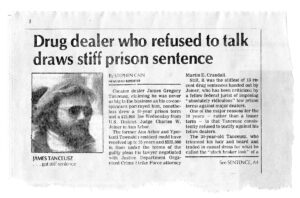Webster Bivens may have been a drug dealer, but his place in law enforcement history is not proportional to his status as an alleged dealer.
In the fall of 1965, Federal Bureau of Narcotics agents raided Bivens’s Brooklyn, N.Y. apartment. The FBN agents had neither an arrest warrant nor a search warrant. The agents arrested Bivens and handcuffed him in front of his family. They also allegedly threatened his family and, in the terminology of Bivens’s later lawsuit, searched his apartment from “stem to stern.” No drugs were found, and the charges filed after Bivens’s arrest were dismissed.

Title III of the Omnibus Crime Act of 1968 prescribed the process to legally intercept wire, oral, or electronic communications—electronic surveillance, or elsur for short.
Bivens brought a civil action suit against the “six unknown agents” for violating his rights under the Fourth Amendment, which guarantees “The right of the people to be secure in their persons, houses, papers, and effects against unreasonable searches and seizures.”
Up until that time, a cause of action could not be brought against the U.S. or its agents except as specifically authorized under certain statutes, and that was the ruling of the lower courts in Bivens’s action. But the Bivens case made it to the U.S. Supreme Court, and in 1971, the court decided that the U.S. could be sued if its agents violated a citizen’s constitutional right.
President Nixon had declared “War on Drugs” in 1969, and the federal government’s approach to investigating and prosecuting drug sales was changing. The FBN agents who arrested Bivens were part of the Department of the Treasury (presumably because drugs like alcohol were viewed as taxable commodities—even though the principal drugs being targeted at that time, heroin, cocaine, and marijuana, were illegal per se). Separately, the Bureau of Narcotics and Dangerous Drugs—later the Drug Enforcement Administration—had been organized in the Department of Justice.
The DEA had limited resources and was under pressure to produce results in terms of arrests and drug seizures. This made it difficult to do long-term investigations targeting the upper echelons of drug trafficking organizations. In the meantime the FBI was learning to utilize tools provided by the Omnibus Crime Act of 1968.
This lengthy act was intended to provide means for federal law enforcement to investigate organized crime. For the FBI that meant La Cosa Nostra, the Mafia. One particular part of the act (Title III) prescribed the process to legally intercept wire, oral, or electronic communications—electronic surveillance or elsur for short. It included telephone wiretaps and surreptitiously placed microphones or bugs, generally referred to as a “wire.”
By design, the probable cause required to get judicial approval for elsur was difficult to meet. The affidavit often ran well in excess of 100 pages. Among other things, there had to be a showing that other investigative techniques wouldn’t work—for example, if a drug dealer would only deal with someone he had known for years, it would be very difficult to get him to deal with an undercover agent.
Once the affidavit and accompanying order are written, they have to be submitted to the U.S. attorney general or a specifically designated assistant AG for approval. If they are approved, they then have to be authorized by a U.S. District Court judge in the district where the elsur is to be conducted. The elsurs are limited to 30 days, but can be renewed based on an updated affidavit.
In 1982, the FBI was given collateral jurisdiction with the DEA to conduct drug investigations. Up until then, the FBI had no drug jurisdiction. One of the primary reasons was that the FBI had demonstrated success in investigating organized crime using elsur and other techniques.
—
 The agency hit the ground running. The FBI not only had an advantage with the techniques it had mastered, but it also had a physical presence all over the U.S.
The agency hit the ground running. The FBI not only had an advantage with the techniques it had mastered, but it also had a physical presence all over the U.S.
I was special agent in charge of the Ann Arbor office. Like other agents, I had developed a symbiotic working relationship with local law enforcement. In Michigan the police didn’t have any authority to intercept oral or telephonic communications. The feds could provide that. We also integrated IRS and DEA into the investigations.
In Michigan in early 1982, there were several drug investigations initiated by the FBI working with local police. Based on source information, work of undercover police/federal agents, and physical surveillance, probable cause was developed to pursue elsur coverage targeting upper-echelon drug dealers.
Investigations in Flint and Saginaw led to information about a large marijuana distribution operation in Ann Arbor. That operation turned out to be even bigger than we thought. Ultimately all the members of the organization were prosecuted. The leaders were brothers, Ned and Fred Shure, who the media dubbed the “Barons of Pot.” Ned, a successful businessman exclusive of the marijuana business, and Fred, a professor of nuclear physics at the University of Michigan, made millions, tax free, from the sale of literally semi-truck loads of pot. The Shure brothers eschewed distribution of drugs other than marijuana, but not everyone in their organization did.
In Ann Arbor, the FBI wiretapped and bugged the home of Albert Papson Jr., a sub-dealer of the Shures. That led to overhearing a conversation between Papson and James Tanceusz (rhymes with Kansas). Tanceusz had stopped by Papson’s home to discuss selling him 8 oz. of cocaine. When the conversation was overheard, we didn’t know who Papson was talking to.
Fortunately there was a physical surveillance of Papson’s home. The surveillance team was able to identify Tanceusz and follow him home. Based on that encounter an investigation of Tanceusz was begun and assigned to me.
The Ann Arbor Police Department’s Special Investigations Unit had tracked Tanceusz and his associates since late 1978 through surveillance, debriefing confidential informants, and reviewing business, financial, and telephone records. However, they were unable to infiltrate the organization or gather enough conspiracy evidence to justify prosecution.
—
Tanceusz was an interesting character. He had been on the Michigan football team in 1969 when Bo Schembechler arrived. Bo was a daunting task master and laid down the challenge that those who stayed would be champions. Tanceusz didn’t stay on the team, but he did graduate from the U-M.
The FBI had also established a relationship with the telephone company (in those days there was only one), and had agents trained to know how to install wiretaps. These “technical” or “tech” agents worked with certain telephone employees who were sworn to secrecy. The tech agents were also trained to do surreptitious entries—burglaries—in order to place the bugs. These entries were requested in the elsur affidavit and authorized by the U.S. District Court judge, and had to be carefully choreographed to avoid detection.
Tanceusz’s house was a single-story ranch in the country; there were no nearby neighbors, and he didn’t have a dog or an alarm system. The bug was placed in the living room, but was sensitive enough to pick up conversations in other parts of the house. This was both a benefit and a problem. If Tanceusz played music or had the TV on, it would tend to drown out the conversations. (There were ways to filter out the extraneous noise, but not completely.)
For the bug, the tech agents installed a separate phone line, and an observant person might have noticed an extra line running from the house to the pole. Tanceusz did have the house painted while the wire was up, and we were concerned that the painter would notice the extra line—he didn’t. It would have been possible to use a radio transmitter instead of a hard wire, but transmitters had distance limitations and emanated a signal which could be detected or might interfere with other devices. (This was state of the art over forty years ago.)
 After the installation, the wiretap/bug had to be monitored and recorded by an agent, and it had to be done according to strict rules. All those involved in the monitoring had to be briefed as to the case and who could be listened to. There is a requirement of “minimization,” that is, only the persons who had been identified as subjects of the elsur could be monitored. If someone is heard who has not been identified as part of the conspiracy and is not conversing with a known member of the conspiracy, they can’t be monitored. The monitoring/recording machines were wired in such a way that as long as an agent could hear the conversation, they knew it was recorded.
After the installation, the wiretap/bug had to be monitored and recorded by an agent, and it had to be done according to strict rules. All those involved in the monitoring had to be briefed as to the case and who could be listened to. There is a requirement of “minimization,” that is, only the persons who had been identified as subjects of the elsur could be monitored. If someone is heard who has not been identified as part of the conspiracy and is not conversing with a known member of the conspiracy, they can’t be monitored. The monitoring/recording machines were wired in such a way that as long as an agent could hear the conversation, they knew it was recorded.
For each telephone line or bug there were two recorders: one was the “original” and the tape was maintained as evidence; the other was a working copy. The working copy was used for review and some “violation” conversations were transcribed.
Logs were kept by the monitoring agents that showed on/off times, incoming/outgoing calls, summaries of conversations, and “foot marks” so anyone reviewing the tape could easily locate specific calls. A “five-day” report was usually required to be provided to the authorizing judge. The judge was then generally made aware of the status of the elsur and what evidence, if any, was being developed. In Tanceusz’s case, the violation conversations—those that related to drug trafficking—were enough to help justify a thirty-day extension of the wire, so it ran for a total of sixty days.
Tanceusz, as is often the case with a wire, became the best witness for the prosecution. He was careful when talking on the phone and was cryptic when discussing drugs, but he was candid in the “privacy” of his home. On several occasions he said that he received and distributed forty pounds of pure cocaine per year.
—
On June 2, 1982, Tanceusz told Rick Schrope, a friend and sub-dealer, that he would be getting six to seven pounds of “extra high-quality coke” that would cost more than his customary price of “nineteen” (price per oz. in hundreds of dollars or $1,900). Shrope said he would take a pound.
Less than a week later, FBI, DEA, IRS, and police raided Tanceusz’s home pursuant to a search warrant. The agents found 1.6 lbs. of pure cocaine in a “secret” compartment behind a medicine cabinet.
When the search was completed, Tanceusz was left with a copy of just the search warrant (not the affidavit that justified it, which was sealed) and an inventory of what was taken. He didn’t realize that the raid resulted from electronic surveillance.
Afterward, he made incriminating telephone calls and statements overheard on the bug. Those conversations would help identify and strengthen the cases against Tanceusz’ co-conspirators. It was an example of what we called “tickling the wire,” taking an action that prompts the suspect to provide further information.
After the search and the termination of the wire, all the information gleaned from the wire was analyzed and members of the conspiracy and other potential witnesses were interviewed. (Anyone recorded during the elsur who could be identified had to be given notice that they were intercepted.) The IRS began a “net worth” investigation of Tanceusz. He had no legitimate source of income, yet from the wire we learned that he would buy uncut jewels like rubies and emeralds from Southeast Asia. Then he would try to appear to sell them for a profit to launder his drug profits.
Ultimately Tanceusz was indicted along with members of his conspiracy. He was charged with operating a “continuing criminal enterprise,” the severest federal drug trafficking statute. Conviction would have meant a mandatory minimum ten-year prison term, and could have resulted in a life sentence.
Rather than go to trial, Tanceusz pleaded to lesser charges. The judge sentenced him to ten years for cocaine distribution. There is no parole in the federal system, so ten years pretty much means ten years.
The last time I saw him he was in a minimum-security federal correctional facility in Ft. Worth, Texas. It wasn’t hard time, but Tanceusz wasn’t adapting well to prison.
On several occasions while his conversations were being intercepted, Tanceusz had railed about drug dealers who had cut deals and testified against other dealers. He said he would never do that. But he had called and asked me to visit him as he had information for me.
He provided me with information about other drug dealers and said he would be willing to testify. Unfortunately, it was information we already had and his testimony was of no value. Timing is everything—information, like groceries, has a shelf life, and his was past the expiration date.
After the search of Tanceusz’s home, he had complained in an interview with the media that federal investigators had blatantly violated his Fourth Amendment rights. But this was no redux of the Webster Bivens’s case. Tanceusz learned that the game had changed, but we had followed the rules.
Stejskal is the author of FBI Case Files Michigan: Tales of a G-Man, from which this article is excerpted. An earlier version of this article was previously published on TickleTheWire.com.

